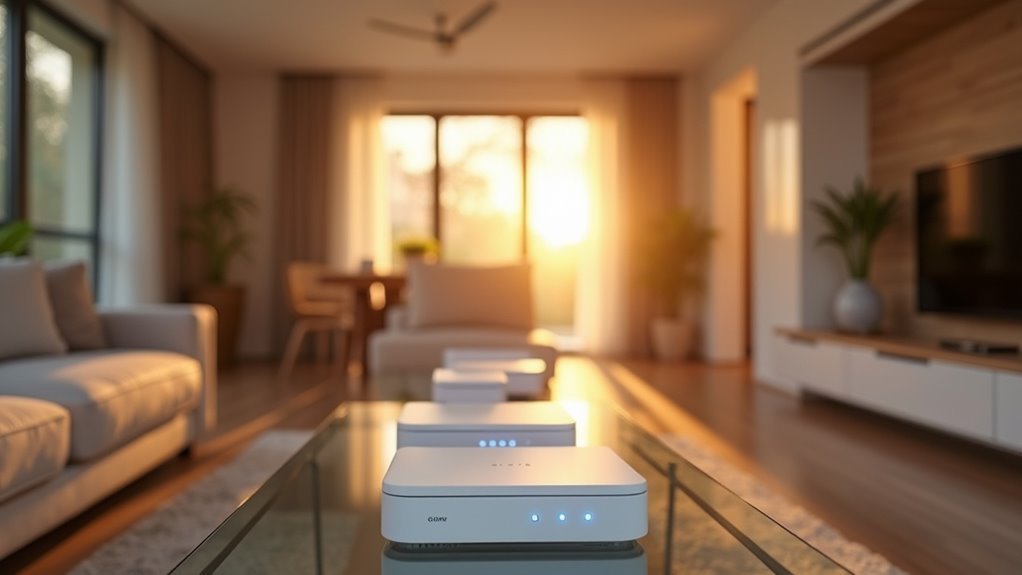You’ve probably experienced that frustrating moment when your WiFi signal drops to nothing in certain areas of your home. Whether it’s your bedroom upstairs or that corner office where you work, dead zones can turn your reliable internet connection into a source of constant irritation. While traditional solutions like WiFi extenders promise to fix the problem, they often create more issues than they solve, leaving you with multiple network names and inconsistent performance that’ll make you question your setup choices.
Understanding WiFi Dead Zones and Their Root Causes

While you might expect your WiFi to reach every corner of your home, Wi-Fi dead zones can frustrate your daily connectivity needs and leave certain areas with weak or nonexistent signals. These problematic spots occur when your wireless signal can’t penetrate physical barriers like walls, furniture, and appliances effectively.
Traditional routers typically broadcast signals within 100 to 300 feet, but structural materials such as brick, metal, and concrete greatly degrade transmission strength. Your coverage area becomes even more compromised when you’re dealing with device congestion from multiple connected gadgets competing for bandwidth.
Poor router placement compounds these issues—hiding your router in closets or positioning it far from high-demand areas creates additional dead zones that limit your home’s connectivity potential.
What Is a Mesh WiFi Network and How Does It Work
You’ve identified your WiFi dead zones, but now you need a solution that actually eliminates them rather than just extending weak signals.
A mesh WiFi network consists of multiple interconnected nodes—a main router plus satellite units—that work together to blanket your entire space with strong, consistent coverage.
Unlike traditional extenders that create separate networks, mesh systems operate as one unified network where each node communicates with the others to automatically route your devices to the strongest available signal.
Mesh Network Definition
Dead zones disappear when you deploy a mesh WiFi network—a system of multiple interconnected nodes that work together to blanket your entire space with consistent wireless coverage. Unlike traditional routers that broadcast Wi-Fi signals from a single point, mesh networks strategically position multiple nodes throughout your home network to guarantee peak coverage reaches every corner.
Each node communicates with others, creating a unified network that your connected devices seamlessly shift between as you move around. You’ll experience uninterrupted connectivity without switching networks or entering passwords.
| Traditional WiFi | Mesh Network |
|---|---|
| Single access point | Multiple interconnected nodes |
| Coverage gaps common | Extensive coverage |
| Manual network switching | Automatic device handoff |
This intelligent design eliminates dead zones while maintaining consistent performance across your entire property.
How Mesh Works
Three key components make mesh WiFi networks remarkably effective: intelligent node communication, seamless device handoffs, and unified network management.
Each node constantly communicates with other nodes using advanced routing protocols, creating multiple pathways for your Wi-Fi signal to travel throughout your space. This interconnected system eliminates dead zones by automatically selecting the strongest connection path for peak performance.
As you move around your home or office, mesh networks seamlessly hand off your devices between nodes without interruption. You’ll experience uninterrupted connectivity because nodes work together under one SSID and password.
The system intelligently routes traffic through the best available path, ensuring consistent coverage throughout your entire area. Modern mesh systems support both wireless and wired backhaul connections, further enhancing reliability and performance.
Calculating Your Home’s Coverage Requirements

Before investing in a mesh network system, you’ll need to assess your home’s specific coverage requirements to secure peak performance.
Start by calculating your total square footage – homes up to 1,500 sq. ft. typically need 1-2 nodes, while larger spaces over 2,000 sq. ft. may require 3 or more nodes.
For optimal mesh network performance, calculate your home’s square footage first – smaller homes need fewer nodes than larger spaces exceeding 2,000 sq. ft.
Consider structural factors like walls and floors that can block your Wi-Fi signal transmission.
Walk through your home to identify dead zones where connectivity drops off – these areas will guide strategic node placement for mesh Wi-Fi systems.
Factor in interference from smart devices and appliances that can impact performance.
Choose expandable systems that allow adding nodes as needed, and always check manufacturer specifications for coverage capabilities to guarantee adequate distribution throughout your unique layout.
Determining the Optimal Number of Mesh Nodes
Once you’ve mapped out your coverage requirements, you’ll need to determine exactly how many mesh nodes will deliver the performance you’re seeking. For homes up to 1,500 square footage, you’ll typically need 1-2 mesh nodes for ideal coverage.
Larger homes exceeding 2,000 square feet require 3 or more nodes to eliminate stubborn dead zones.
Your home’s layout considerably impacts node placement. Thick walls and multiple levels weaken signal strength, necessitating additional nodes.
Follow the two-room rule when positioning satellites, keeping them within 30 feet of each other vertically and near power outlets.
Most mesh systems offer expandable systems, so start with baseline requirements and add nodes as needed.
Place nodes in open spaces rather than enclosed areas for maximum effectiveness.
Strategic Node Placement for Maximum Coverage

You’ll need to position your mesh nodes strategically to eliminate dead zones and enhance coverage throughout your home.
Proper spacing between nodes prevents signal overlap while avoiding interference from appliances and metal objects that can disrupt connectivity.
Testing your coverage areas after placement guarantees you’re getting peak performance from each node’s position.
Optimal Node Spacing
Strategic placement of your mesh network nodes determines whether you’ll eliminate dead zones or create new ones. You’ll achieve ideal Wi-Fi coverage by following the two-room rule, positioning satellite nodes within visual range of your main router while maintaining strategic spacing.
| Distance | Coverage Area | Signal Quality |
|---|---|---|
| 15-20 feet | Single floor | Excellent |
| 20-25 feet | Through walls | Good |
| 25-30 feet | Between floors | Adequate |
Keep satellite nodes within 30 feet of each other, especially between different levels. Position them near power outlets in open spaces, avoiding interference from appliances and thick walls. Use in-app signal tests to verify your mesh systems deliver signal in every corner. Proper node placement guarantees seamless connectivity throughout your home without creating coverage gaps.
Avoiding Signal Interference
While proper spacing establishes your mesh network’s foundation, environmental interference can undermine even the most carefully planned node placement.
You’ll need to strategically position your nodes away from physical obstructions like brick walls, metal furniture, and large appliances that disrupt Wi-Fi signals and reduce coverage effectiveness.
Keep your mesh nodes clear of electronic devices that emit radio waves, particularly microwaves and Bluetooth devices, which cause significant interference and degrade signal quality.
Position nodes in open spaces on elevated surfaces like shelves rather than floors to enhance signal propagation throughout your home.
Use your mesh system’s app to regularly test signal strength and monitor for interference issues.
This allows you to adjust node placement when coverage needs change or new interference sources appear.
Testing Coverage Areas
After addressing interference sources, proper testing reveals whether your node placement actually delivers the coverage you need.
Use your mesh system’s app to conduct thorough testing coverage throughout your home, checking Wi-Fi signal strength in every room. Walk around with your smartphone, noting areas where signal drops or network performance suffers.
Most mesh apps display real-time signal indicators, helping you identify spots requiring additional nodes. Test during peak usage times when multiple devices connect simultaneously, as this reveals true performance under load.
If you discover weak zones, relocate existing nodes or add new ones within 30 feet of current positions. Focus on ideal placement in open areas, avoiding thick walls and interference sources.
Retest after adjustments to confirm improved signal strength and eliminate remaining dead zones.
Step-by-Step Mesh Network Setup Process
Setting up a mesh network requires careful preparation and systematic execution to guarantee peak performance throughout your home.
Start the setup process by downloading your mesh network’s mobile app, which’ll guide you through each step. Disconnect your existing router, then connect the main router node to your modem using an Ethernet cable in a central location.
Follow the app’s instructions to create your network name and password.
Next, strategically position satellite nodes throughout your home, following the two-room rule while keeping them within range of the main router. Use the app to test signal strength and monitor performance continuously.
Make placement adjustments as needed to eliminate stubborn dead zones and optimize your network’s coverage.
Choosing Between Wired and Wireless Backhaul Options
How do you decide whether your mesh network should rely on wired or wireless connections between nodes?
Consider your home’s layout and connectivity requirements. Wired backhaul uses Ethernet cables to connect satellite nodes directly to your main router, delivering superior performance with stable connections and reduced latency. This option works best for larger homes where you can run cables without obstructions.
Wireless backhaul offers flexibility since nodes communicate without physical cables, making setup easier in open spaces. However, you’ll experience potential interference and speed reduction over distance.
Dual-band mesh systems use one band for devices and another for backhaul, while tri-band systems include a dedicated backhaul band for enhanced performance.
Most mesh systems provide mobile app controls to switch between options and optimize settings for your specific network needs.
Configuring Your Mobile App for Network Management
Once you’ve established your backhaul connections, you’ll need to download your mesh system’s dedicated mobile app to complete the setup and manage your network effectively.
The mobile app serves as your control center for your mesh Wi-Fi system, allowing you to create a secure network with a unique SSID and password.
Use the app’s built-in tools to test signal strength and optimize nodes placement throughout your home. This guarantees maximum coverage and eliminates remaining dead zones.
The app also provides access to parental controls, letting you set time limits and content restrictions for specific devices.
Monitor your network regularly through the app by checking connected device lists and usage patterns. This helps maintain security and quickly identify unauthorized connections to your mesh network.
Testing Signal Strength and Coverage Areas
Once you’ve configured your mesh network’s mobile app, you’ll need to test signal strength throughout your home to identify remaining weak spots.
You can use the app’s built-in testing tools to measure Wi-Fi quality as you walk through different rooms and floors.
This testing process helps you optimize coverage areas by revealing where you might need to adjust node placement or add additional satellites.
Signal Strength Testing Methods
Before installing mesh network nodes throughout your home, you’ll need to map your current Wi-Fi coverage to identify exact dead zones and weak signal areas.
Testing your signal strength provides critical data for ideal mesh system placement.
Use these effective testing methods:
- Download mobile apps like NetSpot or Wi-Fi Analyzer to create detailed coverage maps and visualize signal distribution throughout your space.
- Conduct physical walkthrough tests by moving around with a connected device, noting where your Wi-Fi signal drops or disconnects completely.
- Leverage built-in mesh system apps that offer real-time feedback on node performance and connectivity status.
- Test at different times throughout the day to account for varying network usage and interference patterns.
- Document areas below -70 dBm threshold where testing results indicate you’ll need strategic node placement for improved coverage.
Coverage Area Optimization
After mapping your Wi-Fi dead zones, you’ll need to enhance your mesh network’s coverage area through strategic node placement and ongoing performance monitoring.
Place each mesh node within 30 feet of another to maintain strong signal strength throughout your home. Follow the two-room rule when positioning satellites, keeping them near power outlets in open spaces to maximize Wi-Fi coverage and eliminate dead zones.
Use your mesh system’s app or LED indicators to conduct regular signal tests and identify weak spots.
Calculate your home’s square footage during assessment to determine ideal node placement locations. Monitor network usage and client lists consistently to detect interference issues that could affect your coverage area enhancement.
This proactive approach guarantees your mesh networks deliver reliable connectivity everywhere.
Implementing Parental Controls and Device Prioritization
While mesh networks excel at eliminating dead zones, they also provide powerful tools for managing your family’s internet usage through extensive parental controls and device prioritization features.
These advanced systems let you create individual profiles for family members, giving you complete control over when and how your connected devices access the internet. You’ll manage screen time effectively while ensuring critical devices receive ideal bandwidth through Quality of Service settings.
Complete family internet control through personalized profiles and smart bandwidth management for every connected device in your home.
Key parental control and prioritization features include:
- Creating customized internet schedules and content filtering for each family member
- Pausing internet access instantly for specific devices during homework or bedtime
- Setting usage limits to promote responsible internet habits among children
- Prioritizing bandwidth for streaming services, gaming consoles, or work devices
- Receiving alerts when new devices join your network for enhanced security
Smart Home Integration With Mesh Systems
You’ll find that modern mesh systems like Amazon’s eero come with built-in smart hubs such as Zigbee, eliminating the need for separate hardware to connect your smart devices.
This integration simplifies your device setup by letting you manage everything through a single app interface rather than juggling multiple platforms.
Your home automation becomes more reliable since mesh networks guarantee your smart lights, thermostats, and security cameras maintain stable connections throughout your entire home.
Built-In Smart Hubs
When you’re building a smart home ecosystem, mesh systems with built-in smart hubs can eliminate the complexity of managing multiple devices and platforms. These integrated solutions streamline your connectivity by combining Wi-Fi mesh functionality with Zigbee technology, letting you control smart devices without additional hardware.
Key benefits of mesh systems with built-in smart hubs include:
- Centralized control through a single mobile app for both network and device management
- Direct device connection for lights, locks, and thermostats without separate hubs
- Enhanced automation features that create schedules and routines for energy efficiency
- Reduced hardware clutter by eliminating the need for multiple smart home hubs
- Cost savings from consolidated functionality in one system
You’ll enjoy simplified setup and seamless integration across your entire smart home network.
Device Connection Simplification
Beyond eliminating hub clutter, mesh systems transform how your smart devices connect and communicate throughout your home. Your mesh Wi-Fi network creates seamless connectivity by providing each smart home device with direct internet access without additional hardware requirements.
You’ll experience unified network management through a single SSID and password that lets devices roam freely between nodes without reconnecting.
The integrated device app simplifies control by centralizing management of all connected appliances, from thermostats to security cameras. You can monitor, customize, and adjust settings remotely while staying within your network’s coverage area.
This streamlined approach eliminates the complexity of managing multiple connection protocols, creating an intuitive smart home ecosystem where every device communicates efficiently through your mesh infrastructure.
Enhanced Home Automation
As mesh systems evolve into extensive smart home platforms, they’re revolutionizing home automation by integrating essential connectivity hubs directly into their hardware.
Unlike traditional Wi-Fi extenders, mesh networks provide thorough smart home infrastructure that eliminates dead zones while managing your connected devices.
You’ll benefit from these integrated features:
- Built-in Zigbee hubs eliminating need for additional smart home hardware
- Centralized management through mobile apps for monitoring all devices
- Bandwidth prioritization using QoS settings for ideal smart home device performance
- Reliable connectivity ensuring security cameras and smart locks maintain communication
- Regular firmware updates maintaining security and compatibility with evolving technologies
This integrated approach transforms your mesh network from simple connectivity into a powerful automation platform that manages smart home devices seamlessly throughout your entire home.
Network Security and Monitoring Best Practices
While mesh networks excel at eliminating dead zones, they’re only as secure as the practices you implement to protect them.
Network security starts with regularly updating your mesh system’s firmware to patch vulnerabilities and boost performance. You’ll want to activate built-in anti-malware tools that quarantine infected devices and protect against malicious content.
Regular firmware updates and active anti-malware tools form your first line of defense against network vulnerabilities and infected devices.
Monitoring becomes effortless through your mesh app, which tracks network usage and alerts you when new devices connect. This visibility helps you spot unauthorized access quickly.
Configure parental controls to create safer online environments for children by restricting inappropriate content access.
Don’t overlook Quality of Service settings—they’ll prioritize bandwidth for critical devices while giving you greater control over network traffic during peak usage times.
Maintaining and Updating Your Mesh System
Once you’ve implemented strong security practices, consistent maintenance becomes your mesh network’s lifeline for peak performance.
Regular upkeep guarantees your system operates efficiently while protecting against emerging threats.
Essential maintenance tasks include:
- Check firmware updates regularly through your mesh app to receive security patches and performance enhancements from manufacturers
- Monitor network usage and review client lists to spot unauthorized devices that could compromise security or slow performance
- Enable anti-malware utilities built into most mesh systems to guard against viruses and malicious content automatically
- Schedule periodic signal strength tests via the app to evaluate each node’s performance and enhance coverage
- Set notifications for new devices joining your network to quickly identify potential security threats or unauthorized access attempts
These proactive steps maintain ideal node placements and network integrity.
Mesh Networks Vs Wifi Extenders: Making the Right Choice
Two fundamentally different approaches exist for eliminating WiFi dead zones in your home: mesh networks and WiFi extenders.
You’ll find that mesh networks create seamless coverage using multiple nodes operating as one network, while Wi-Fi extenders establish separate networks with different SSIDs, causing connectivity issues when moving between zones.
Mesh systems excel at handling high-bandwidth activities across devices connected simultaneously without signal loss. A single mesh node typically covers over 3,000 square feet, making them perfect for larger homes.
Mesh networks deliver consistent high-bandwidth performance across multiple devices while providing extensive coverage for larger residential spaces.
The system automatically manages connections and optimizes data paths.
Extenders target specific weak spots but often require manual configuration and multiple units for extensive coverage area.
While extenders seem cheaper initially, you’ll likely spend more achieving comparable performance to mesh networks’ all-encompassing solution.
Frequently Asked Questions
Should I Turn off Router Wifi When Using Mesh?
You should turn off your router’s WiFi when using mesh to prevent interference and device confusion. This guarantees all devices connect to your mesh network’s stronger signals instead of your old router’s weaker signal.
What Is the Weakness of Mesh Network?
You’ll face higher costs and potential latency issues with mesh networks. They’re less effective in small spaces, and poor node placement creates dead zones. Some systems require ongoing subscription fees.
Which Router Helps to Eliminate Wifi Dead Zones and Allow for Full Wifi Coverage at Home?
You’ll want mesh routers like TP-Link Deco, eero, or Google Nest systems. They use multiple interconnected nodes throughout your home, creating seamless coverage that automatically switches your devices to the strongest signal available.
Why Is My Mesh Wifi so Bad?
Your mesh WiFi’s likely struggling because you’ve placed nodes too far apart, near interference sources, or without clear sight lines. Too many connected devices, single-band backhaul, or outdated firmware can also cause poor performance.





Leave a Reply